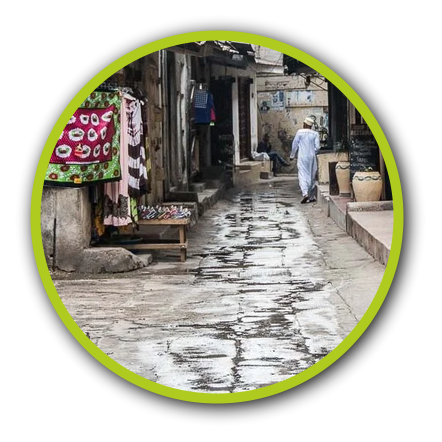Stone Town Tour
Duration: 8 HoursThe tour starts at: 08:00 AM and finishes at 16:00 PM local time
A driver will pick you up and return you to your hotel
Entrance Fees: Yes – included in tour price
Lunch: No (You need to bring from the hotel)
Wheelchair friendly: Yes
Sanitary stops: yes 2
Refreshments: from shops
Sultan’s Palace Museum
The Sultan’s Palace Museum, also known as the Beit al-Sahel or the House of the Breeze, is a historical museum located in Stone Town, Zanzibar. Stone Town is the capital of Zanzibar, a semi-autonomous archipelago off the coast of Tanzania in East Africa.
The Sultan’s Palace Museum is situated on the waterfront, overlooking the Indian Ocean. It was originally constructed in the late 19th century as a residence for the sultans of Zanzibar. The palace was the official residence of the Omani Sultans during their reign over Zanzibar.
House of Wonders
The House of Wonders, also known as Beit-al-Ajaib, is a historic landmark located in Stone Town. It is a prominent and iconic building that serves as a testament to Zanzibar's rich cultural heritage.
The House of Wonders was constructed in the late 19th century and was initially intended to be a ceremonial palace for Sultan Barghash, who ruled over Zanzibar at the time. It earned its name "House of Wonders" due to its remarkable features, such as electricity, running water, and an elevator, which were considered remarkable technological advancements of that era.
Portuguese Fort
The Portuguese fort in Zanzibar refers to the historical structure known as Fort Jesus, which is located on the island of Zanzibar in Tanzania. While Zanzibar has a rich history of Portuguese influence, the main fortification in Zanzibar is of Omani origin.
Fort Jesus, a UNESCO World Heritage site, was constructed by the Portuguese in the late 16th century. At the time, Zanzibar was an important trading center, and the Portuguese established a presence there to control the lucrative spice trade. The fort was designed to defend their interests and secure their dominance over the region.
Freddy Mercury House
Freddie Mercury, the legendary lead vocalist of the band Queen, was born on September 5, 1946, in Stone Town, Zanzibar (which was then a British protectorate, now part of Tanzania). Although he spent his early years in Zanzibar, his family relocated to India when he was a teenager.
Curio Shops and Souvenirs
Curio shops and souvenirs play a significant role in Stone Town’s tourism industry. These shops offer a wide variety of locally crafted items, traditional artefacts, and unique souvenirs that reflect the rich Swahili culture and heritage of Zanzibar.
“Carved Doors” in Stone Town
Zanzibar is known for its unique and beautiful carved doors, which are considered a traditional architectural feature of the region. These doors are typically found in Stone Town, the historic part of Zanzibar City, which is the capital of Zanzibar, a semi-autonomous archipelago off the coast of Tanzania. The Zanzibar curved doors are renowned for their intricate designs and craftsmanship.
“Narrow Streets” in Stone Town
Stone Town, is known for its narrow, labyrinthine streets. These streets are a characteristic feature of the town and reflect its historical and architectural significance.
Darajani Market
The Darajani Market stands out as a local and historic gem. This bustling marketplace has been a hub of trade and commerce for centuries, attracting locals and tourists alike.
Former Slave Market
During the 19th century, Zanzibar became a significant center for the slave trade in East Africa. Arab and Swahili slave traders, primarily of Omani origin, played a prominent role in this trade.
Stone Town & Changuu Island Tour
9 Hour full day Tour:
Forodhani Gardens: A waterfront park famous for its evening food market, where you can try local delicacies like Zanzibari pizza and seafood skewers.
The Old Fort: A 17th-century fort originally built by the Portuguese and later used as a prison and garrison. Today, it houses a cultural centre and hosts events such as the Zanzibar International Film Festival.
The House of Wonders: A grand palace built in the late 19th century, which served as the Sultan’s residence. It is now a museum showcasing Zanzibar’s history and culture.
The Anglican Cathedral: Also known as the Christ Church Cathedral, it stands on the site of the old slave market. The cathedral has a museum and a memorial dedicated to the victims of the slave trade.
The Forodhani Market: Located near the waterfront, this market offers a wide range of local produce, spices, handicrafts, and souvenirs.
Changuu Island, also known as Prison Island.












